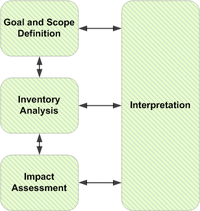
Photo from wikipedia
Abstract Constant increase in energy demand has necessitated exploration of renewable and sustainable alternative sources of energy. Oleaginous yeast can serve as a potential feedstock for biodiesel production and the… Click to show full abstract
Abstract Constant increase in energy demand has necessitated exploration of renewable and sustainable alternative sources of energy. Oleaginous yeast can serve as a potential feedstock for biodiesel production and the recovered de-oiled biomass can be used for production of energy-dense bio-crude by hydrothermal liquefaction (HTL), a precursor for advanced bio-fuels. Life cycle assessment (LCA) of yeast based biofuel production is of existing and must be performed to gauge the possible environmental impacts and obtain a holistic picture. Accordingly, a detailed LCA study encompassing all the sub-processes in biodiesel and bio-crude production in a yeast biorefinery model was executed. Combined analysis of the mid-point and end-point indicators revealed that HTL and transesterification have comparatively higher impacts than the other sub-processes. Climate change indicator results show an emission of 4.02E3 kg CO2 eq. for HTL step and resource depletion for transesterification was estimated to be $773. The major reason for the impacts can be attributed to the usage of large amount of input energy/electricity for both the processes. The use of solvents, namely, methanol and glycerol in various downstream processing steps have contributed to around 60–70% towards the impact categories. Sensitivity analysis revealed higher lipid productivity can reduce CO2 emissions by 16% and resource depletion by 6.5%. The environmental performance of the process can be improved by replacing the electricity from fossil fuel with renewable energy sources such as solar or hydroelectric power with simultaneous recycling and reuse of the solvents and waste heat.
Journal Title: Journal of Cleaner Production
Year Published: 2020
Link to full text (if available)
Share on Social Media: Sign Up to like & get
recommendations!